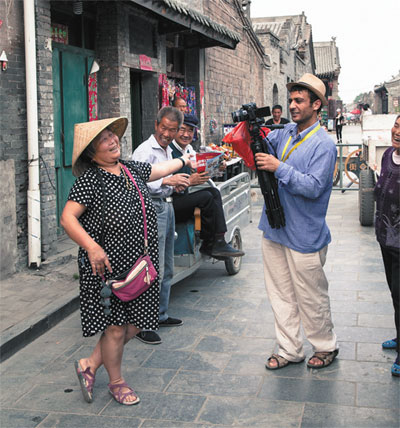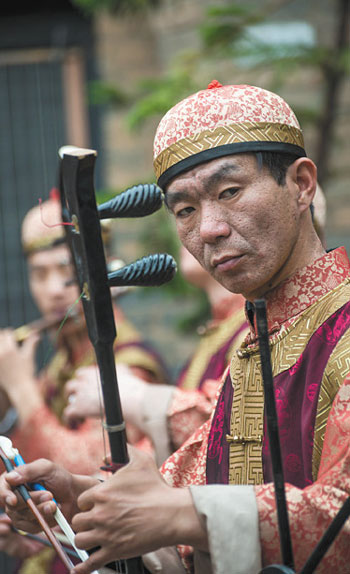Step into another China, where rich treasures await
A group of foreigners, sponsored by the Shanxi Tourism Bureau and China Daily, took a five-day tour in May to absorb scenes of stunning natural beauty and thousands of years of cultural heritage. Randy Wright reports.
What's a tourist to do? You've hammered years off your life in the nightclubs of Shanghai and shopped till you dropped in Hong Kong. You've seen all the historical and cultural sites in Beijing, maybe more than once - Tian'anmen Square, the Forbidden City, the Old Summer Palace, the towers of Bell and Drum. You've been to the Great Wall and other world-class attractions, and temples galore.
What else is there?
Sit down, and inhale slowly. The fact is, you haven't really been to China. That long bucket list you thought was complete is mere prologue. You've scratched the surface, but you haven't yet penetrated the main artery of Chinese culture and history or seen some of the country's most spectacular natural wonders.
You are still a novice, a fledgling, a greenhorn, a neophyte, a putterer, a dabbler, an infant. You have yet to experience the next level. It's time to toddle into a new adventure - and that's surprisingly easy to do.
That next step takes you into Shanxi province, a comfortable train ride west of Beijing. Once you take it, you'll never look at China the same way again.
Land of Avatar
The ancient state of Jin - today's Shanxi province - holds more than 70 percent of China's oldest and best preserved architectural treasures, three UNESCO World Cultural Heritage sites, and five National Tourist Attractions that have earned the country's top 5-A rating.
Wonders crowd every corner of the map: In the north, the Xuankong Temple hangs from a sheer cliff, and the Yungan Grottoes of Buddhism, hidden for 1,500 years, reveal their secrets: 252 caves and 51,000 statues. Swing southwest to find the roaring yellow Hukou Waterfall, then southeast for the Grand Canyons of Mount Taihang and the breathtaking Wangmang Ridge, where mist-covered mountains seem to float in the air over an endless void. The similarities with Pandora, the paradise moon in James Cameron's film Avatar are unmistakable. All you need is a flying dragon.
"Chinese people know about these places, but few foreigners do," said tour guide Wang Shaoli.
She is right, but not for long. Word is getting out.
"I think in the next five or 10 years, many foreigners will learn about us," said Wang Wenbao, deputy director of the Shanxi Tourism Bureau.
"You can find history all over China, but not like this," he said. "Here you can see back 5,000 years. It's an important birthplace of Chinese civilization, and endowed with many natural gifts."
Shanxi's collection of splendors is packed into an area of 156,000 square kilometers, which means it's all within easy striking distance of Taiyuan, the capital and largest city, located dead center.
What's in a name?
Shanxi's name (not to be confused with neighboring Shaanxi) derives from a combination of the Chinese word shan, meaning "mountain", and xi, meaning west - basically "west of the Taihang mountains".
China's mother of waters, the Yellow River, draws strength from a major tributary that pours north-to-south through the Shanxi plateau, bordered by mountains. The shape of the land made the region a natural military stronghold for centuries. It fulfilled that purpose admirably for emperors and generals from the Spring and Autumn Period (770-476 BC) through World War II, when it served as a base of operations against Japanese invaders.
Unforgettable
Shanxi's long military history suggests an ideal destination for first-time foreign visitors. It's the Old Town of Pingyao (also called Pingyao Ancient City). It is the easiest World Cultural Heritage cultural site to reach, just 100 kilometers south of Taiyuan. Simply stay on the train: It stops virtually at the gates of one of China's best-kept living museums.
Inside massive 12-meter-high walls, which stretch 6.4 km to encircle the old town, is a tightknit community of only 50,000 whose hearts and hands are aligned to the same goal: preserving China's most complete example of cultural, social, economic and religious development. The open faces and welcoming smiles of the people are unforgettable.
A night at the quaint Pingyao Hall Hotel is unlike any other. It's more than a visit: You become a resident of the ancient town, an integral part of the labyrinth of walls, narrow streets, courtyards, barracks and shops. Even the beds evoke the spirit of old China - wall-to-wall and designed with a space beneath a brick platform for glowing coals on cold winter nights. (They don't use coals nowadays. It's one of the few details that have fallen by the wayside.)
Prosperity's benefits
In the 19th century, Pingyao emerged as an important financial hub in China. The country's banking industry germinated here, with the invention of something like checking accounts that eliminated the need to transport precious metals overland. That put a dent in highway robbery. The resulting prosperity helped to maintain and preserve the structures.
A practical judicial system also developed. Visitors can attend court, view implements of punishment and imagine being caned while kneeling in the indentations cut into the court's stone floor for that purpose. Parents might even find some ideas for dealing with errant adolescents.
An abundance of shops and restaurants cater to the needs of foreign visitors - souvenir hunters and epicureans alike. A wide range of Chinese and Western food and drink is available, and enough English is spoken to get along.
But it's the 600-year-old city wall that stands out. Mounting the parapets, one can pause for a moment and hear the echo of ancient battle cries and cannonades while strolling along the battlements, which in their own way are as impressive as the Great Wall.
Notice that you are now strolling, no longer toddling. These are just the first steps in what could become a series of rich and rewarding ventures into authenticity. According to tourism official Wang, "As far as tourism goes, other places can't keep up with Shanxi."
Contact the writer at randy@chinadaily.com.cn

|
A local woman in Pingyao strikes a pose for a member of the foreigners' tourist group. Li mengyuan / for China Daily |
|
A musician plays for visitors at the Royal Residence of the Prime Minister in Jincheng. Luis Gomez / for China Daily |
(China Daily 06/18/2015 page6)
















